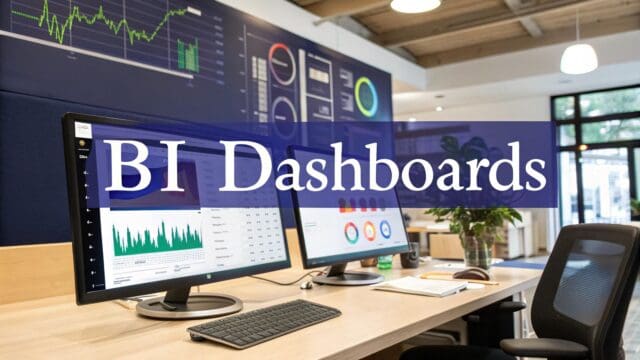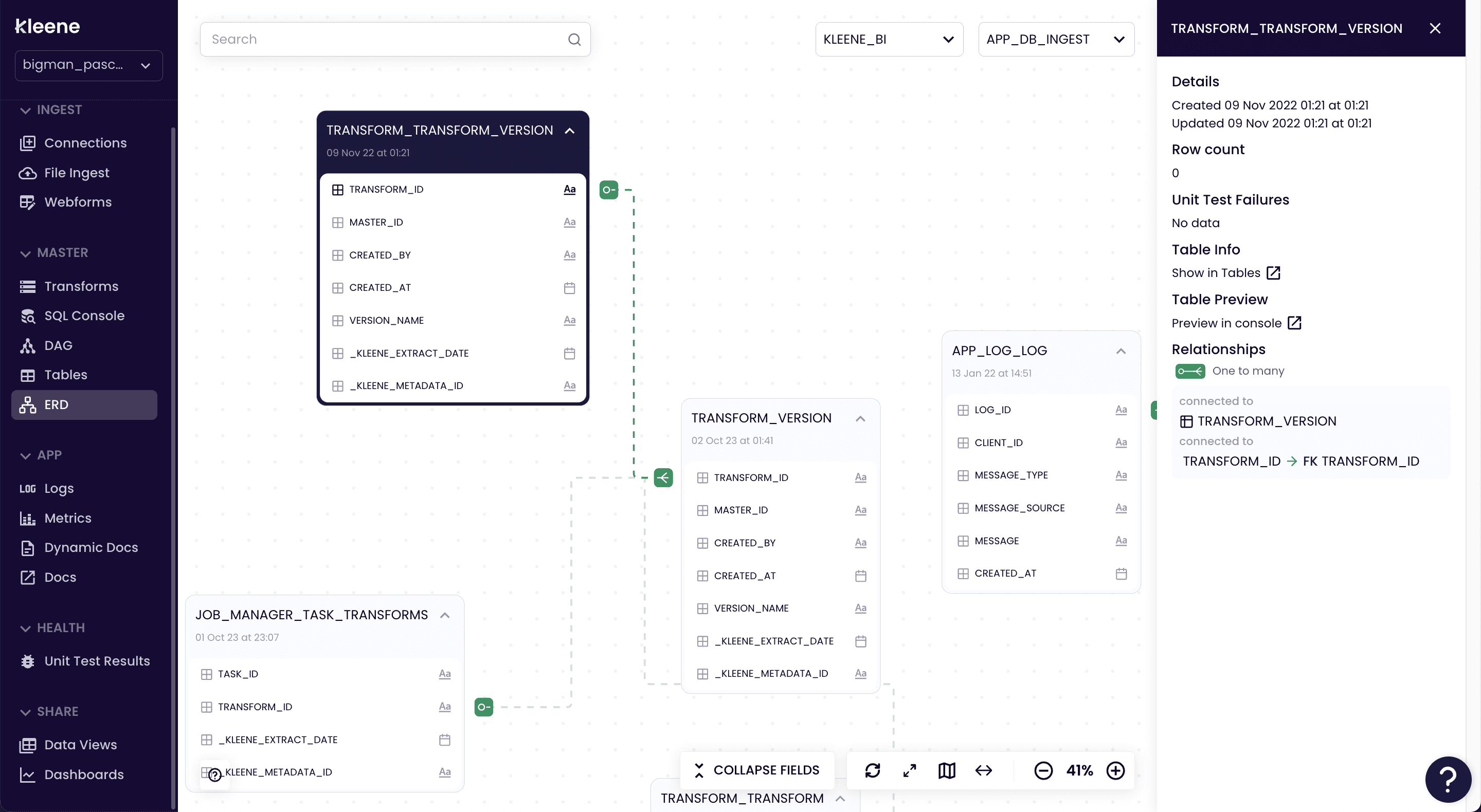Unlocking Insights with Business Intelligence Dashboards
Making smart business decisions requires quickly understanding complex data. Business intelligence (BI) dashboards have become essential tools for organizations to visualize and act on their key performance metrics. These dashboards have evolved from basic static reports into dynamic, interactive platforms that help teams monitor performance and spot important trends.
A well-designed BI dashboard strikes the right balance between simplicity and depth. It tells a clear story through data, highlighting the metrics that matter most while revealing meaningful patterns. Understanding core design principles – from choosing effective visualizations to customizing the view for different users – helps unlock the full value of your data.
In this guide, we'll examine 10 real-world examples of business intelligence dashboards across different departments and industries. You'll see how organizations use these tools day-to-day and learn practical tips for creating impactful dashboards tailored to your needs. Whether you're in finance, operations, sales or leadership, you'll discover how the right dashboard can transform raw data into actionable business insights.
1. Sales Performance Dashboard
A Sales Performance Dashboard is essential for tracking and improving sales activities. It gives teams and leaders a complete view of their most important sales data, helping them spot trends, catch issues early, and make smarter decisions about where to focus their efforts.
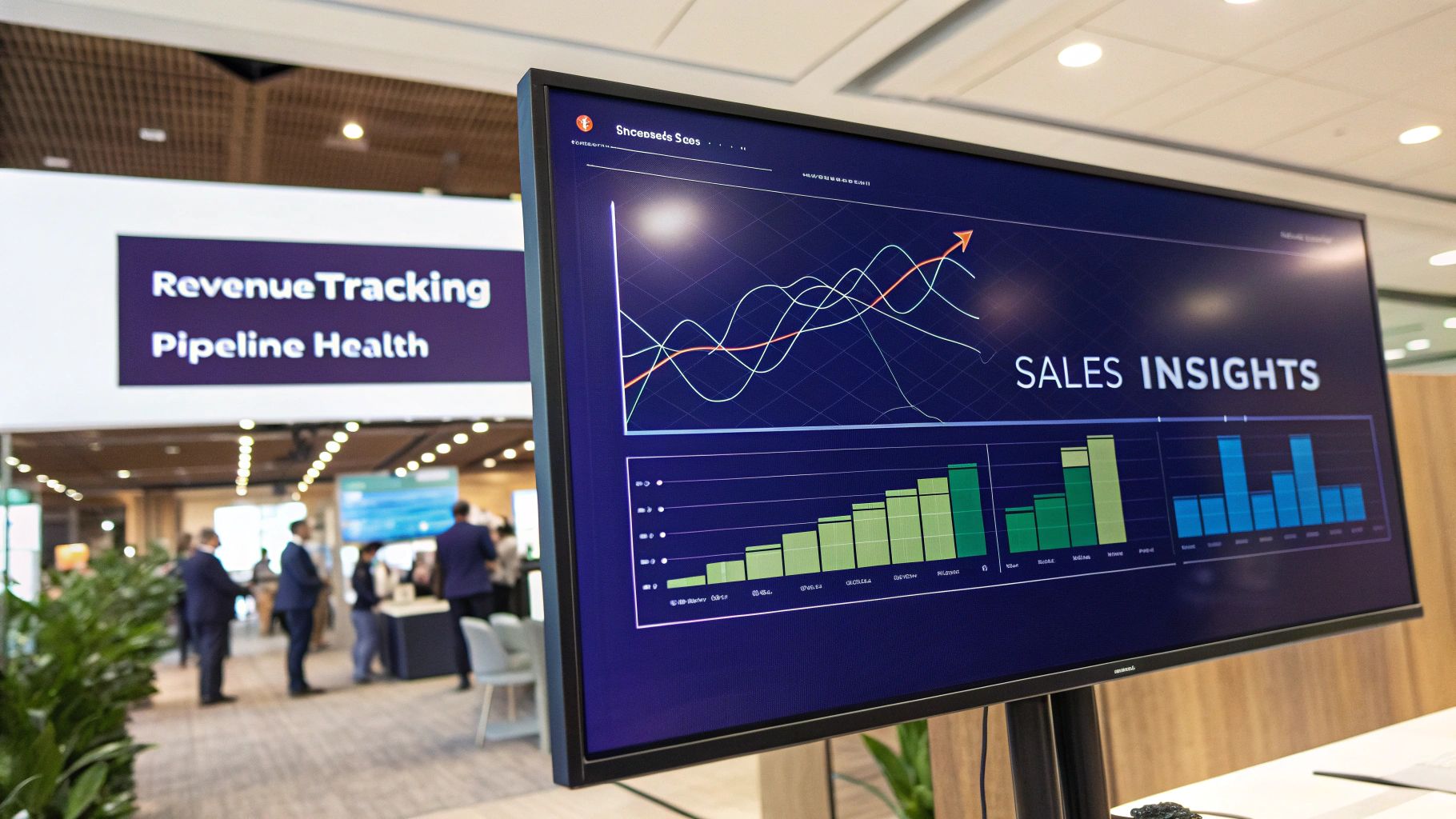
Key features typically include:
- Revenue tracking: See current revenue vs targets and project future earnings based on past performance
- Pipeline views: Monitor deals as they move through sales stages to spot any bottlenecks
- Team analytics: Track how individual reps and teams perform against goals
- Regional breakdowns: View sales data by location to identify strong and weak markets
- Product insights: Analyze which products drive the most revenue and which need attention
Real Example: A sales manager notices declining numbers in one region through their dashboard. Digging deeper into the data reveals that a specific product isn't selling well there. This allows them to quickly provide extra training or adjust their strategy for that area.
Tools & Technology: The growth of Salesforce, Tableau, and Microsoft Power BI has made these dashboards more powerful and easier to use. These platforms help teams gather and analyze large amounts of sales data quickly.
Benefits:
- Visual KPIs: See key metrics through simple charts and graphs
- Current data: Make decisions using the latest information
- Flexible views: Different team members can see the data most relevant to their role
- Pattern recognition: Quickly spot sales trends and opportunities
Challenges:
- Data overload: Too many metrics can make the dashboard hard to use
- Upkeep needed: Regular updates required to keep data accurate
- Setup time: May need adjustments to match your specific needs
Popular Examples:
Implementation Tips:
- Choose key metrics: Focus on the most important numbers
- Use consistent colors: Make data easy to understand at a glance
- Show comparisons: Include data from past periods
- Enable detailed views: Let users click through for more information
By following these guidelines and using sales dashboards effectively, companies can better understand their sales performance and make more informed decisions to grow their business.
2. Executive KPI Dashboard
An Executive KPI Dashboard shows the most important business metrics in one place, giving top leaders a clear view of company performance. This specialized tool helps executives quickly understand how the business is doing and spot areas that need attention. By presenting vital data in a clear format, it enables smarter strategic decisions.
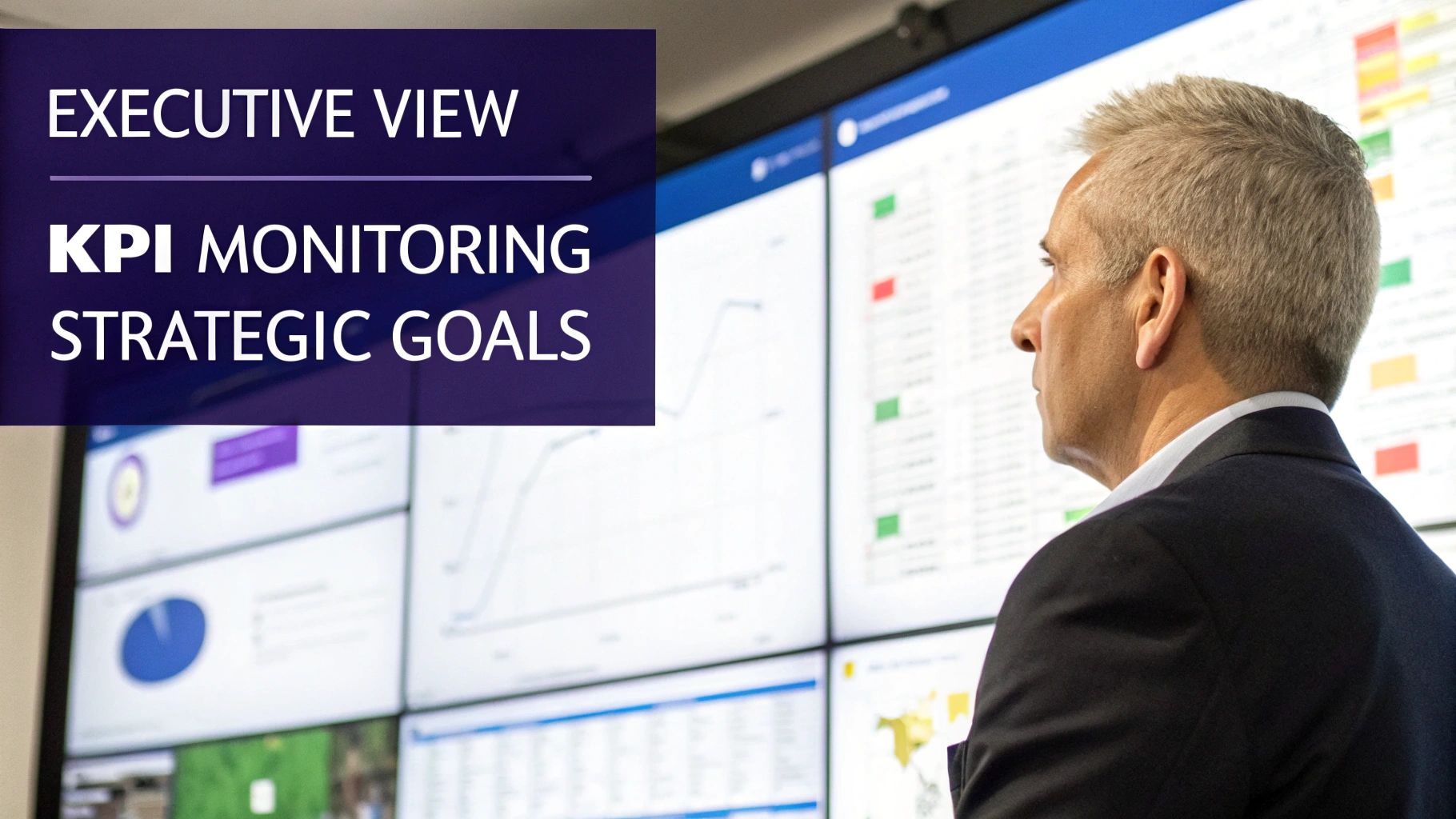
Features and Benefits:
Key components typically include:
- Company Performance Tracking: Monitor essential metrics across departments to see the full picture
- Financial Overview: Track revenue, profits, and expenses for quick financial health checks
- Goals and Progress: Measure advancement toward strategic targets. Learn more about aligning your metrics: How to define your North Star Metric
- Risk Monitoring: Identify potential issues early for better risk management
- Market Analysis: Track market share and competitor activity
Pros:
- Complete Overview: See all key business data in one place
- Strategic Alignment: Keep decisions tied to company goals
- Department Insights: Understand how different teams affect each other
- Better Decision Making: Use real data to guide choices
Cons:
- May Oversimplify: High-level views can miss important details
- Metric Selection Critical: Choosing wrong metrics reduces effectiveness
- Cost Considerations: Quality dashboards require investment in tools and expertise
Examples:
Popular dashboard solutions include:
- Domo Executive Dashboard
- Geckoboard C-Suite Templates
- Klipfolio Executive Scorecards
Implementation Tips:
- Stay Focused: Show only the most important information
- Show Changes: Include trends and changes over time
- Clear Visuals: Use simple, easy-to-read charts and graphs
- Mobile Ready: Ensure access on phones and tablets
Growth and Changes:
Tools like Domo, Sisense, and Looker have made executive dashboards more common and useful. These platforms make it easier to gather and show data from many sources. As businesses rely more on data for decisions, these dashboards have evolved from basic reports to dynamic tools showing real-time insights. This helps executives make faster, smarter choices to improve business results.
3. Marketing Analytics Dashboard
A Marketing Analytics Dashboard helps teams track and understand their marketing results in one central view. It combines important metrics like campaign performance, ROI tracking, and channel analytics to give business leaders clear insights into what's working and what's not. For modern companies, having good marketing data analytics is essential for making smart decisions.
Key Features and Benefits:
Marketing Analytics Dashboards typically include:
- Campaign Performance Tracking: See how individual campaigns perform across email, social media, paid ads, and organic search. Monitor metrics like impressions, clicks, conversions, and cost per acquisition.
- Lead Generation Metrics: Track website visits, form submissions, and how many leads become customers to measure lead generation success.
- Social Media Analytics: Get data on social engagement, follower growth, reach, and sentiment to improve social strategies.
- Content Performance: See how content performs through page views, time on page, bounce rates, and social shares.
- Marketing ROI Calculation: Connect revenue back to specific campaigns and channels. Learn more: Ultimate Guide to Marketing ROI: Definition, Strategies & Results
Real Examples:
Picture a retail company launching new products. Their marketing dashboard shows which social posts drive sales, helping them focus budget on the best channels. Or take a software company using their dashboard to identify top-performing blog posts and understand how readers become customers.
How These Dashboards Evolved:
Marketing analytics dashboards started as basic reporting tools but grew into powerful platforms offering real-time data and predictive insights. Companies like Google Analytics, Adobe Analytics, and Marketo helped drive this growth.
Benefits and Challenges:
Benefits:
- Channel Insights: See which marketing channels perform best
- Clear ROI Data: Easily show the value of marketing spend
- Real-Time Optimization: Adjust campaigns based on live data
- Audience Understanding: Learn how people interact with your brand
Challenges:
- Data Integration: Combining data from many sources takes work
- Attribution Issues: Hard to track which touchpoints led to sales
- Maintenance Needs: Regular updates required for accuracy
Making It Work:
- Focus on Sales Metrics: Track leads, revenue, and customer value
- Watch Costs: Monitor cost per acquisition across channels
- Map Customer Paths: See how people move from first click to purchase
- Compare Performance: Check your metrics against industry standards
A good marketing analytics dashboard helps teams see what's working, make better decisions, and get more from their marketing budget.
4. Financial Performance Dashboard
A Financial Performance Dashboard helps organizations monitor and analyze their financial health in real time. It gives finance teams, executives, and stakeholders instant access to key metrics like cash flow, profitability, and financial ratios. This type of dashboard makes raw financial data meaningful and actionable.
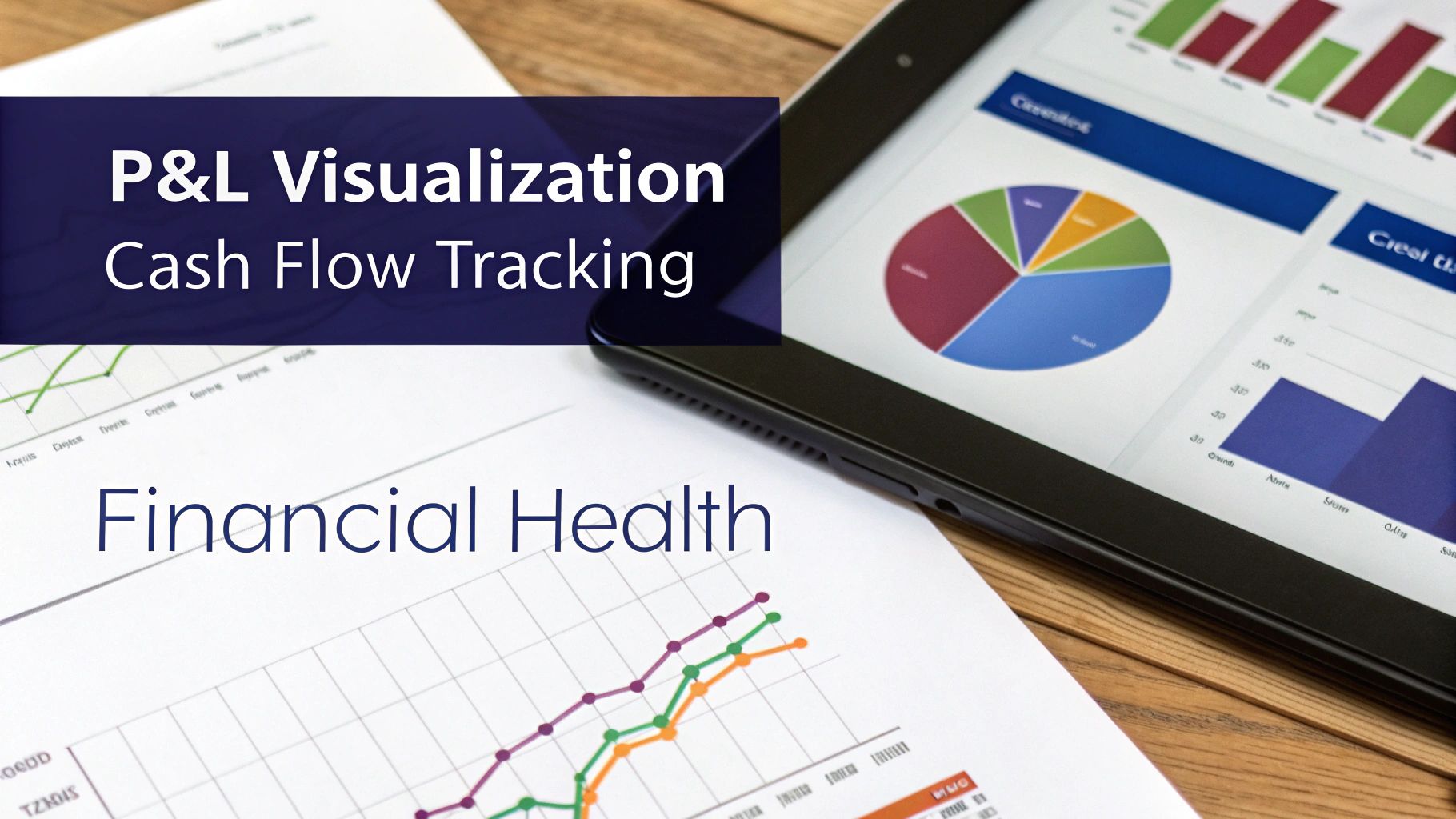
Key Features and Benefits:
Most Financial Performance Dashboards include:
- P&L Statement Visualization: Shows interactive views of profit and loss data, making it easy to analyze revenue, expenses, and net income
- Cash Flow Tracking: Monitors money coming in and going out to understand liquidity and stability
- Budget vs. Actual Analysis: Compares planned versus actual results to spot variances and areas needing attention
- Financial Ratios: Displays key metrics like profitability margins and liquidity ratios for deeper performance insights
- Expense Monitoring: Breaks down costs by category to identify where money is being spent
These features provide clear benefits:
- Complete Financial Picture: Shows the full scope of financial performance in one view
- Compliance Support: Makes it easier to generate required regulatory reports
- Future Planning: Uses historical data to help predict future trends
- Detailed Analysis: Enables users to examine specific data points closely
Real World Impact:
Consider a retail business using their dashboard during a sales campaign. By watching metrics like revenue, costs, and marketing spend in real time, they can quickly see if the promotion is working and adjust as needed. This beats waiting weeks for traditional reports. Popular tools like QuickBooks, SAP, and Oracle offer these capabilities.
History and Growth:
Financial dashboards have grown with advances in business intelligence and data visualization. Early tools from SAP, Oracle and Intuit laid the groundwork. Now cloud platforms make these tools accessible to companies of all sizes.
Pros and Cons:
Pros:
- Shows complete financial picture
- Helps meet compliance requirements
- Enables better forecasting
- Allows detailed data exploration
Cons:
- Takes time to set up properly
- Requires strong data security
- Need financial expertise to use effectively
Implementation Tips:
- Track Variances: Regularly check actual versus budget numbers to catch issues early
- Use Alerts: Set notifications for important metric changes
- Verify Data: Ensure dashboard information is accurate and current
- Cross-Check: Compare dashboard data with other systems regularly
You might be interested in: FP&A Meaning: The Essential Guide to Modern Financial Planning & Analysis to learn more about financial planning's role in business strategy.
For data teams, executives, finance professionals and CFOs, Financial Performance Dashboards are must-have tools. They provide clear insights that help organizations track performance, spot trends, and make smart decisions about resources and growth.
5. Customer Service Dashboard
A Customer Service Dashboard shows you exactly how well your customer support team is performing. It tracks customer satisfaction, team efficiency, and support operations – key information for data teams, executives, and finance leaders to enhance customer retention and get the most from support resources.
The most effective dashboards include core features like:
- Ticket Status Tracking: See open, pending, resolved and escalated tickets at a glance, helping spot backlogs that need attention
- Response Time Metrics: Monitor first response time, average response time, and resolution time to gauge team speed
- Customer Satisfaction Scores (CSAT): Measure customer happiness through feedback surveys to assess support quality
- Agent Performance Metrics: Track ticket volume, resolution rates, and customer ratings for each agent to identify top performers and training needs
- Service Level Agreements (SLAs): Ensure support team meets promised response and resolution time commitments
Real Example: Consider an online retailer during Black Friday sales. Their dashboard reveals response times slowing as ticket volume spikes. They quickly add more support staff to maintain service levels. The CSAT scores also highlight which products generate the most customer issues, helping improve future offerings.
Industry Growth: Platforms like Zendesk, ServiceNow, and Freshworks have made customer service dashboards accessible to companies of all sizes. As businesses focus more on customer experience, data-driven support has become essential.
Benefits:
- Real-time Monitoring: Catch and fix issues quickly
- Customer Insights: Understand pain points and needs
- Team Performance: See who excels and who needs coaching
- Process Improvement: Identify and resolve recurring problems
Challenges:
- Information Overload: Too many metrics can distract agents
- Ongoing Attention: Requires regular monitoring to be useful
- Custom Setup Needed: Standard dashboards may need adjustments
Platform Examples: Zendesk Analytics, Freshdesk Reporting, ServiceNow Dashboard
Implementation Tips:
- Focus on Speed: Quick responses boost satisfaction
- Track Resolution: High resolution rates reduce customer effort
- Review Feedback: Pay attention to CSAT scores and comments
- Set Clear Goals: Define realistic performance targets
Related resources: Learn more about Churn Risk prediction. Customer churn directly impacts revenue and growth, especially for subscription businesses.
6. HR Analytics Dashboard
HR Analytics Dashboards help companies make smart decisions about their workforce by showing key data about employees, hiring, and company performance in one place. These dashboards have become essential tools for modern HR teams who want to base their strategies on solid data rather than guesswork.
Understanding and Application:
HR teams use these dashboards to turn complex employee data into clear insights. Instead of digging through multiple spreadsheets, managers can quickly spot important patterns in areas like employee performance, hiring success, and team demographics. This helps them make better choices about finding, developing, and keeping talented employees.
For example, a dashboard might show that certain training programs directly improve employee performance, making it clear which programs deserve more investment. It can also highlight if hiring or promotions favor certain groups, helping address potential fairness issues.
Real-World Examples:
A major retail chain used their HR dashboard to study why employees were leaving different stores. The data showed higher turnover in locations with certain management approaches. After providing targeted leadership training to store managers, employee turnover dropped significantly.
In another case, a tech company tracked their hiring process through their dashboard. By analyzing which recruiting methods worked best and how long it took to fill different roles, they made their hiring faster and less expensive.
Growth and Development:
HR Analytics Dashboards became more common as companies gathered more employee data and better tools emerged to analyze it. Companies like Workday and ADP helped make these dashboards popular by building analytics right into their HR systems. As more businesses saw how data could improve their HR decisions, demand for user-friendly dashboards grew quickly.
Key Features:
- Performance Tracking: Monitor key metrics like productivity, sales goals, and project completion
- Hiring Analytics: Track time-to-hire, hiring costs, candidate sources, and job acceptance rates
- Turnover Analysis: Understand why employees leave and what it costs
- Training Impact: See how training programs affect employee skills and results
- Team Demographics: View age, gender, and other data to promote fairness
Benefits:
- Better Understanding: Get clear insights into workforce trends
- Smart Retention: Create data-backed plans to keep valuable employees
- Performance Tracking: Monitor employee results effectively
- Legal Compliance: Stay on top of labor law requirements
Challenges:
- Privacy Issues: Must carefully protect sensitive employee information
- Data Interpretation: Risk of drawing wrong conclusions from data
- Metric Selection: Can be hard to choose the right things to measure
Implementation Tips:
- Protect Privacy: Make data security a top priority
- Check Engagement: Watch employee satisfaction levels closely
- Track Diversity: Monitor workplace fairness metrics
- Stay Current: Update dashboard data regularly
Popular Platforms:
HR Analytics Dashboards earn their spot on this list because they help companies make smarter decisions about their most important asset – their people. These tools give leaders clear insights into their workforce, leading to better business results and more engaged employees. For data teams, executives, and financial leaders, these dashboards provide vital information about the people driving company success.
7. Supply Chain Dashboard
A Supply Chain Dashboard is a tool that shows real-time information about inventory, logistics, suppliers, and supply chain performance in one central view. For business leaders and data teams, it provides clear visibility into their supply chain operations from start to finish, helping them make smarter decisions about moving products from raw materials to finished goods.
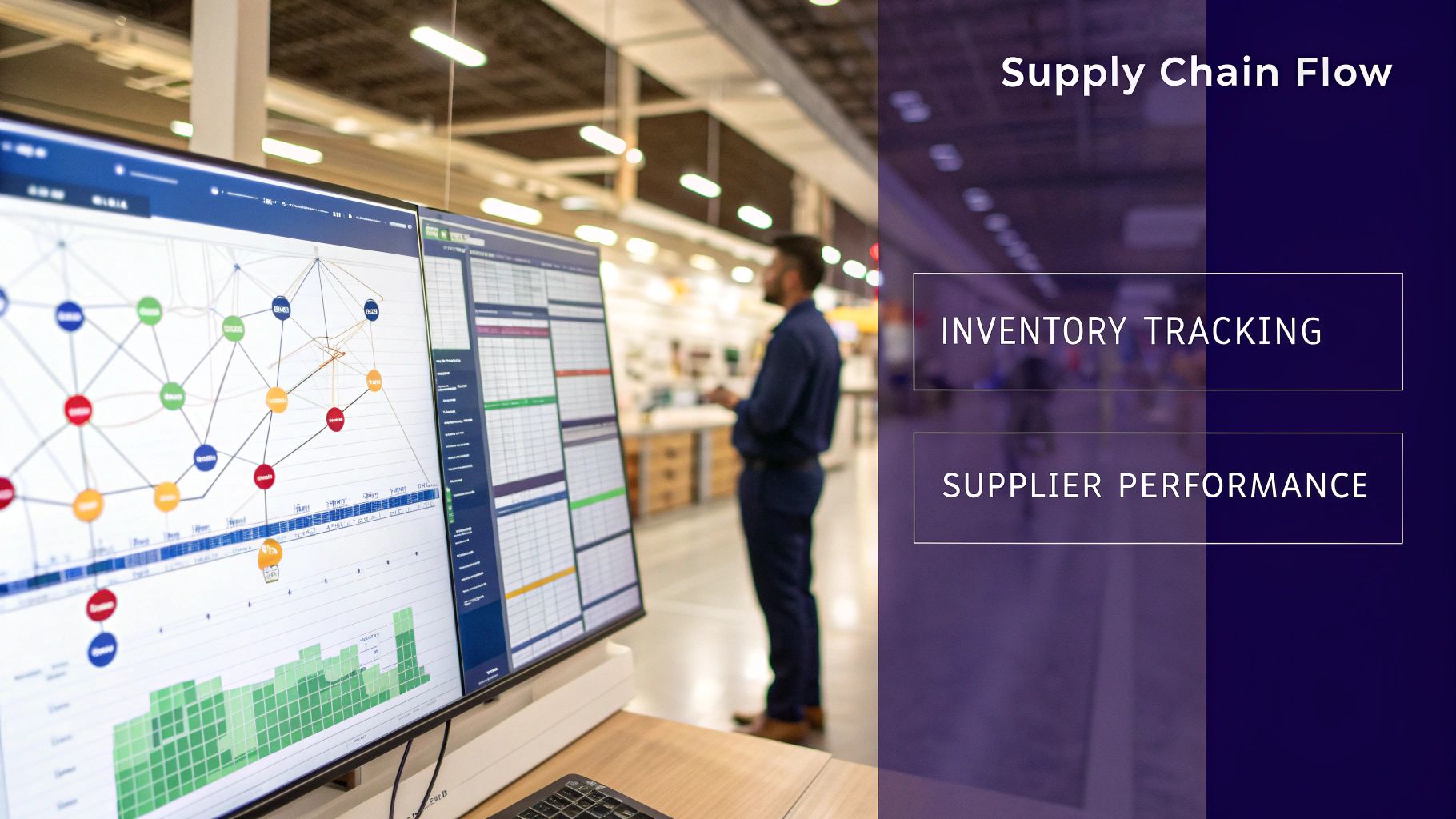
Key Features:
- Inventory Tracking: See current stock levels across locations to prevent shortages and excess inventory. Learn more: Days Inventory Outstanding: A Smart Guide to Inventory Success
- Supplier Metrics: Monitor supplier delivery times, quality scores, and lead times
- Logistics Overview: Track shipments, delivery status, and transportation costs
- Order Management: Follow orders from placement through delivery
- Cost Analysis: Break down supply chain costs to find savings opportunities
Benefits:
- Complete Visibility: See your entire supply chain in one view
- Better Risk Management: Spot potential issues before they become problems
- Performance Tracking: Monitor key metrics to improve operations
- Cost Savings: Find and fix inefficiencies
Challenges:
- Data Integration: Combining data from multiple systems can be difficult
- Real-Time Updates: Keeping information current requires significant resources
- Stakeholder Alignment: Getting everyone to work together takes effort
Popular Platforms:
- SAP Supply Chain Analytics
- Oracle SCM Cloud
- Manhattan Associates
Market Growth:
As supply chains became more complex globally, companies needed better ways to track and manage operations. Major software providers developed supply chain tools initially for large companies. Now, cloud technology has made these dashboards available to businesses of all sizes.
Implementation Tips:
- Focus on your most important supply chain areas first
- Keep close watch on supplier delivery times
- Track key supplier performance metrics
- Include early warning indicators for potential problems
A supply chain dashboard is essential for modern business success. When companies manage their supply chains well, they gain a real competitive edge. For more insights on inventory management, check out Days Inventory Outstanding: A Smart Guide to Inventory Success.
8. Project Management Dashboard
A Project Management Dashboard brings together key project data in one place, making it easy to track multiple projects at once. By displaying essential metrics like timelines, budgets, resources, and risks, it helps teams stay informed and make better decisions. Data teams, executives, and finance professionals rely on these dashboards to keep projects running smoothly.
These dashboards do much more than basic task tracking. They offer a complete view of project health through features like timeline charts, resource allocation views, budget trackers, and risk indicators. Teams can quickly spot which projects are on schedule, where resources may be stretched thin, and if costs are staying within budget. Clear milestone markers help ensure key deliverables stay on track.
Real-world Examples:
Picture a marketing team managing several campaigns at once. Their dashboard shows each campaign's progress, spending, and team assignments in one view. The marketing manager can instantly see if any campaigns are falling behind or over budget and take action.
For software teams, the dashboard tracks sprint progress, outstanding bugs, and developer workloads. This transparency helps development teams collaborate more effectively.
Industry Adoption:
As projects grow more complex, project management dashboards have become essential tools. Popular platforms like Jira, Monday.com, and Asana make it simple to set up custom dashboards that fit different project needs. Their easy-to-use interfaces have helped drive widespread use across industries.
Benefits:
- Better Project Visibility: Shows the status of all projects clearly, improving team communication and understanding
- Smart Resource Use: Helps assign people and resources efficiently across projects
- Timeline Control: Makes it easy to track progress and adjust plans to meet deadlines
- Easy Status Updates: Provides quick access to current project data for stakeholder reports
Drawbacks:
- Needs Regular Updates: Keeping data current requires consistent effort
- Can Get Overwhelming: Managing many projects in one dashboard may become complex
- Resource Conflicts: While the dashboard shows resource allocation, it can't prevent all scheduling conflicts
Implementation Tips:
- Set Update Schedule: Pick specific times to refresh dashboard data
- Use Clear Indicators: Choose distinct colors (red/yellow/green) to show project status
- Track Resources Well: Monitor team workloads to spot potential bottlenecks early
- Show Key Risks: Make potential project risks and impacts clearly visible
Project Management Dashboards have earned their spot on this list by making complex project management simpler. Their ability to show project status at a glance and help teams catch issues early makes them vital for successful project delivery.
9. E-commerce Analytics Dashboard
An E-commerce Analytics Dashboard is a vital tool for tracking how your online store performs. It puts all your key business data in one place, helping you make smarter decisions about sales, customer service, and daily operations. Its impact on sales and revenue make it essential for any online business.
The dashboard brings together data from multiple sources and turns raw numbers into clear insights that show not just what's happening in your store, but why those trends matter.
Key Features:
- Sales Tracking: Monitor real-time data on revenue, average order value, and top products. See which items sell best and when peak sales occur.
- Customer Analysis: Learn about your shoppers' demographics, browsing habits, and buying patterns. Use this to create better targeted offers and build customer loyalty.
- Stock Management: Keep tabs on inventory levels and predict future demand. Avoid running out of popular items or having too much unsold stock.
- Cart Analysis: See why customers abandon carts and find ways to complete more sales.
- Conversion Tracking: Follow customers from first visit to purchase. Find and fix problems in your sales process.
Advantages:
- Live Performance Data: See how your store is doing right now and respond quickly to changes
- Better Customer Understanding: Learn what your shoppers want and how to keep them coming back
- Smart Inventory Control: Keep the right amount of stock and increase profits
- Sales Growth Insights: Find what drives your revenue and set the right prices
Challenges:
- Data Overload: Bigger stores generate huge amounts of data that can be hard to process
- System Connections: Getting different software tools to work together smoothly takes work
- Multiple Data Sources: Combining information from various places needs technical skills
Popular Platforms:
- Shopify Analytics: Built-in tools showing sales, customer, and marketing data
- WooCommerce: Shows key store metrics like orders and customer information
- Magento Business Intelligence: Advanced reporting for deeper business insights
Implementation Tips:
- Track conversion rates at each step of your sales process
- Study why customers abandon carts and try to win them back
- Map out how customers use your store and make improvements
- Set up alerts for low stock to prevent running out
Industry Leaders:
Shopify, Amazon, and Magento led the way in making powerful analytics tools available to businesses of all sizes. Their work helped make data-driven decisions standard practice in online retail.
Real Success Story: A clothing retailer used their dashboard to spot high cart abandonment in one product category. The data showed customers were leaving because of shipping costs. After offering free shipping, sales went up significantly.
For business leaders and data teams, these dashboards are now essential tools. The ability to understand and act on store data isn't optional anymore – it's crucial for staying competitive and growing your business.
10. IT Operations Dashboard
An IT Operations (ITOps) dashboard gives IT teams a central view of their infrastructure's health and performance. This tool helps monitor technology systems, prevent issues, and keep critical services running smoothly. It's an essential way for organizations to use data insights to maintain reliable IT operations.
Key metrics tracked on these dashboards include:
- System Performance: CPU usage, memory, disk space, and other vital system stats that help spot bottlenecks early
- Network Status: Traffic flows, bandwidth usage, connection issues to ensure networks run optimally
- Security Data: Intrusion attempts, malware detections, vulnerability scans to protect against threats
- Service Desk Stats: Ticket volumes, resolution speeds, user satisfaction to improve support quality
- Resource Usage: Server, database and application utilization to optimize capacity
Real-World Impact:
Consider a major retail site during Black Friday sales. Their ITOps dashboard flags a server cluster nearing capacity, letting the team add resources before any slowdown affects shoppers. Or take a bank using their dashboard to catch unusual network patterns that could signal an attack, enabling quick protective measures. Major streaming services depend on these tools to deliver reliable video to millions of users.
Growth and Development:
As IT systems grew more complex, the need for better monitoring tools grew too. Companies like Splunk, New Relic, and Datadog created powerful platforms that collect and analyze IT data in real-time. This shifted IT teams from reacting to problems to preventing them.
Key Benefits:
- Live Monitoring: See infrastructure status as it happens
- Early Warning: Catch and fix issues before they cause outages
- Better Performance: Find and remove system bottlenecks
- SLA Tracking: Ensure service commitments are met
Main Challenges:
- Setup Complexity: Requires technical expertise to implement properly
- Ongoing Attention: Need dedicated staff to monitor and respond
- System Integration: Can be difficult connecting different IT tools
Setup Tips:
- Configure Alerts: Set notifications for critical metrics
- Focus on Core Systems: Monitor your most important services first
- Watch Response Times: Track how fast applications perform
- Regular Updates: Keep dashboard data accurate with maintenance
For business and IT leaders, these dashboards provide crucial insight into their technology health. With real-time monitoring and early problem detection, organizations can keep their IT systems reliable and efficient. The dashboard helps teams prevent outages, maintain performance, and deliver dependable services to users.
Top 10 BI Dashboard Design Comparison
| Dashboard Design | Complexity (🔄) | Resources (⚡) | Outcomes (📊) | Advantages (⭐) | Ideal Use Cases (💡) |
|---|---|---|---|---|---|
| Sales Performance Dashboard | Moderate – multiple metrics and customization required | High – real-time updates and ongoing data maintenance | Real-time sales trends and forecasting insights | Customizable views and clear KPI visualization | Sales teams and executives needing actionable insights |
| Executive KPI Dashboard | Moderate – careful metric selection is key | High – cross-department integration and potential high cost | High-level cross-functional business overview | Concise, strategic insights with executive-friendly visualizations | C-suite executives and strategic leadership teams |
| Marketing Analytics Dashboard | High – involves complex data integration and attribution | Moderate – requires diverse channel-specific data | Detailed campaign performance and ROI tracking | Optimizes marketing spend and conversion analysis | Marketing teams monitoring multi-channel performance |
| Financial Performance Dashboard | High – complex setup with detailed financial modeling | High – demands robust data security and comprehensive financial data | In-depth tracking of cash flow, profitability, and forecasts | Comprehensive financial insights with drill-down capabilities | Finance teams needing regulatory compliance and forecasting |
| Customer Service Dashboard | Moderate – customization across various service metrics | Moderate – real-time feeds with constant monitoring | Immediate insights on service levels and response times | Enhances customer experience management and team performance | Customer support centers and service management teams |
| HR Analytics Dashboard | Moderate – involves sensitive data and complex metrics | Moderate – requires regular updates while ensuring privacy protection | Workforce performance and recruitment trend analysis | Supports retention planning and compliance monitoring | HR departments tracking talent and organizational health |
| Supply Chain Dashboard | High – intricate data integration across multiple systems | High – demands real-time tracking and integration of multi-stakeholder data | End-to-end supply chain visibility with risk indicators | Enhances risk management and cost optimization | Supply chain and logistics management environments |
| Project Management Dashboard | Moderate – dependent on timely updates and coordination | Moderate – resource allocation and scheduling require steady inputs | Clear project progress, milestone tracking, and resource usage | Optimizes timelines and resource utilization | Project managers overseeing multiple projects |
| E-commerce Analytics Dashboard | Moderate – blends sales, inventory, and customer data | Moderate to High – handling large data volumes and multiple data sources | Real-time sales tracking and customer behavior insights | Improves conversion optimization and inventory management | Online retailers and e-commerce performance teams |
| IT Operations Dashboard | High – technical complexity with multiple system integration | High – continuous monitoring and advanced alert systems needed | Proactive system performance and security monitoring | Enables real-time monitoring and effective issue prevention | IT and network operations teams managing critical systems |
Building Your Own Business Intelligence Dashboards
Effective business dashboards give teams instant access to crucial data – from financial metrics and sales performance to marketing ROI and supply chain analytics. The key is focusing on the most meaningful KPIs for your specific needs and presenting them in a clear, actionable way. Whether you're a CFO analyzing costs or a marketing leader assessing campaigns, well-designed dashboards enable fast, informed decisions.
Creating impactful dashboards starts with understanding your data and goals. Carefully consider which metrics directly align with your objectives. What key questions do you need answered? Which data points best track progress? Choose visualization types – like bar charts, line graphs, or maps – that make insights immediately clear and help tell your data's story.
Start simple and refine over time based on real user feedback. The most effective dashboards evolve through iteration as business needs change. Keep up with new developments in data visualization and analytics that can provide deeper insights. AI and machine learning now enable more sophisticated analysis and personalized dashboard experiences.
Key principles for building great dashboards:
- Focus on What Matters: Only include metrics directly tied to your core business goals
- Keep it Simple: Design for quick understanding and easy interpretation
- Drive Action: Ensure insights lead to clear next steps and decisions
- Stay Flexible: Regularly update dashboards as needs evolve
Ready to turn your data into clear insights that move your business forward? Kleene.ai provides the tools and expertise to build powerful business intelligence dashboards. From seamless data integration to AI-powered analytics, we help teams make smarter decisions through data. Visit us to learn how we can help you achieve your goals.
